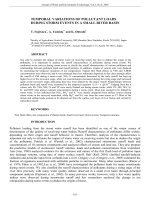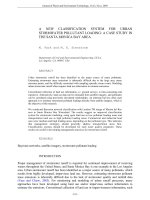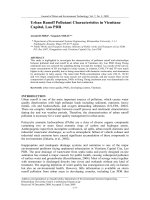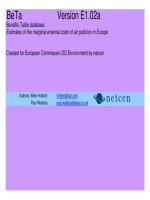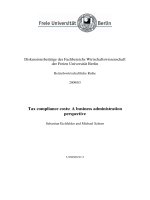Pollutant Trading Could Reduce Compliance Costs If Uncertainties Are Resolved ppt
Bạn đang xem bản rút gọn của tài liệu. Xem và tải ngay bản đầy đủ của tài liệu tại đây (1.55 MB, 20 trang )
Cniteci Staters (knwal Accounting Ofiice
Repok td the Chairman, Committee on
Public Works and Transportation, House
of Representatives
Pollutant Trading
Could Reduce
Compliance Costs If
Uncertainties Are
Resolved ~
llllllllllllllll
147098
RESTRICTED Not to be released outside the
General Accounting Offlce
unless specifically
approved by the Office of Congressional
Relations.
RELEl4s
_
,I ,,,,,,, _~
&W~C:ED-92-153
GAO
t!ni.ted ?+2$;ec; Gmeral Accounting Oflice
_ ,,
‘I
Report to the Chairman, Committee on
I
Public Works and Transportation, House
I
of Representatives
._ .__. __._._._. ._ _ . _ _ _
_~ ._ ._ _
WATEICP~LLUTI~N
Pollutant Trading
Could Reduce
Compliance Costs If
Uncertainties Are
Resolved
,. . .
RESTRICTED Not to be released outside the
General Accounting Office unless specifically
approved by the Office of Congressional
Relations.
5546t4
RELEi’k%
-
_ ___
.
_
_ -
_ _ _ _
GA0/lUxk-92-153
GAO
United Statee
General Accounting OfYice
Washington, D.C. 20648
Reeourcee, Community, and
Economic Development Division
B-247972.2
June 15, 1992
The Honorable Robert A. Roe
Chairman, Committee on Public
Works and Transportation
House of Representatives
Dear Mr. Chairman:
Pollutant trading has been touted within and outside the Environmental
Protection Agency (EPA) as an economical supplement to traditional
regulatory programs designed to address water pollution problems.
Pollutant trading uses cost savings as an incentive for dischargers to
reduce pollution. Under this approach, dischargers of pollution help
determine (with EPA or state assistance and approval) how their
collective discharges can be reduced to preapproved levels in a
cost-effective manner. Within these bounds, pollutant trades can take
place among dischargers of point source pollution (such as effluent from
industrial facilities or municipal sewage treatment plants) or between
dischargers of point and nonpoint source pollution (such as runoff from
farms or construction sites).
This letter responds to your request for information on the use of pollutant
trading as a cost-effective method of dealing with some of the nation’s
remaining water quality problems. As agreed with your office, this report
discusses (1) projects that are using pollutant trading to help solve water
quality problems at a particular watershed area or body of water, (2)
potential barriers that may impede the wider use of pollutant trading, and
(3) EPA’s efforts to implement a nationwide trading program. Also, as
agreed with your office, this report discusses whether statutory or
administrative changes to make trading more viable are warranted.
Results in Brief
-
Pollutant trading to control water pollution has thus far been confined to
four projects nationwide. Only one trade has actually been made so far,
and all but one of the projects involve trading between point and nonpoint
pollution sources. Although each of the projects varies considerably, they
were all initiated by local communities searching for a way to address
water pollution problems while reducing pollution control costs.
The limited activity in pollutant trading nationwide can be largely
attributed to uncertainties surrounding its use. Some in the regulatory and
Page 1
GAO/WED-92.153 Pollutant ‘hadin
, GAO
United States
General
Accounting
Office
Washington, D.C. 20548
Resources, Community, and
Economic Development Division
B-247972.2
June 15, 1992
The Honorable Robert A. Roe
Chairman, Committee on Public
Works and Transportation
House of Representatives
Dear Mr. Chairman:
Pollutant trading has been touted within and outside the Environmental
Protection Agency (EPA) as an economical supplement to traditional
regulatory programs designed to address water pollution problems,
Pollutant trading uses cost savings as an incentive for dischargers to
reduce pollution. Under this approach, dischargers of pollution help
determine (with EPA or state assistance and approval) how their
collective discharges can be reduced to preapproved levels in a
cost-effective manner. Within these bounds, pollutant trades can take
place among dischargers of point source pollution (such as effluent from
industrial facilities or municipal sewage treatment plants) or between
dischargers of point and nonpoint source pollution (such as runoff from
farms or construction sites).
This letter responds to your request for information on the use of pollutant
trading as a cost-effective method of dealing with some of the nation’s
remaining water quality problems. As agreed with your office, this report
discusses (1) projects that are using pollutant trading to help solve water
quality problems at a particular watershed area or body of water, (2)
potential barriers that may impede the wider use of pollutant trading, and
(3) EPA’s efforts to implement a nationwide trading program. Also, as
agreed with your office, this report discusses whether statutory or
administrative changes to make trading more viable are warranted.
Results in Brief
Pollutant trading to control water pollution has thus far been confined to
four projects nationwide. Only one trade has actually been made so far,
and all but one of the projects involve trading between point and nonpoint
pollution sources. Although each of the projects varies considerably, they
were all initiated by local communities searching for a way to address
water pollution problems while reducing pollution control costs.
The limited activity in pollutant trading nationwide can be largely
attributed to uncertainties surrounding its use. Some in the regulatory and
Page 1
GMMRCED-92-152 Pollutant Tradh2
B-247972.2
1999 report on nonpoint pollution,1 the nation’s remaining water quality
problems are largely attributable to pollution from nonpoint sources,
Although 1987 amendments to the act placed additional emphasis on
nonpoint sources of water pollution, the diversity and pervasiveness of
nonpoint source pollution, coupled with the political sensitivity of
regulating land use activities, continues to present an enormous technical
and regulatory challenge for state and local governments.
Over the past decade, pollutant trading has been suggested as an
economical means to address some of the nation’s remaining pollution
problems. Recent amendments to the Clean Air Act, for example,
specifically authorize air emissions trading. Trading’s potential to reduce
the cost of meeting point and nonpoint source water pollution standards
has also received increasing attention in recent years. Under such a
trading scheme, dischargers faced with differing costs for meeting
pollution limits could arrange among themselves (with EPA or state
assistance) how best to allocate the reduction of their total discharges,
while decreasing their costs of meeting the limits.
For example, instead of the need for two sewage treatment plants to
install additional equipment to reduce their discharges, one treatment
plant could help finance the other’s installation of additional, sophisticated
treatment equipment if such an arrangement would yield equivalent (or
better) reductions at lower costs, Trades could also be made between
point and nonpoint sources. For example, instead of installing additional
treatment equipment to reduce its discharge of nutrients, a sewage
treatment plant could pay farmers to use management practices that
would better control the runoff of nutrients from fertilizers or livestock
wastes. In either case, the terms of the trade would then be approved by
EPA or the state and reflected in the discharge permits.
&
Few Trading Projects
On the basis of our literature review and discussions with EPA offMals,
Have Thus Far Been
Initiated
we identified the following four projects in which trading is a component
of a plan to address water pollution2 These projects were initiated by local
groups who were searching for a means to avoid additional-and
increasingly expensive-restrictions on point source dischargers. At three
locations, the projects provide for trading between point and nonpoint
sources as part of a strategy to control phosphorus and other nutrients
‘Water Pollution: Greater EPA Leadership Needed to Reduce Nonpoint Source Pollution
(GAmCED-gllO Oct.
15
- I
,
l@W
. :
*Appendix I contains more detailed information on these four projects.
Pa2e 2
GACWRCED-92=l68 Pollutant ‘hdin#
B-847871.8
that impair water quality. The fourth project permits the trading of
discharge allocations between point sources.
* Dillon Reservoir, Colorado. In 1984 the state of Colorado and EPA
approved a trading program for the Dillon Reservoir to control nonpoint
sources of phosphorus, In the only trade nationwide to date, a sewage
treatment authority received an 1 l-pound credit on its discharge permit
for 22 pounds of phosphorus removed from nonpoint sources when the
authority installed sewers in a small development that had been using
septic tanks. Incentives for additional trades were temporarily eliminated
because treatment plants have improved their operating efficiencies,
which substsntisIly reduced phosphorus discharges into the reservoir.
l
Cherry Creek Reservoir, Colorado. Representatives from the county, local
communities, and water and sanitation districts surrounding the reservoir
formed a trading authority to help address phosphorus pollution from
nonpoint sources, After authority members achieve a SO-percent reduction
of annusl phosphorus loadings from nonpoint sources, they may make
excess reductions available to sewage treatment plants in the form of a
pollution credit. Trading will likely be delayed because anticipated land
development has not materialized and treatment plants are operating well
within their phosphorus load allocations.
l
Tar-Pamlico River Basin, North Carolina. The state established a total,
allowable discharge level for the basin. The state approved a strategy
whereby an sssociation of sewage treatment plants can meet this level
either by making modifications to their facilities and/or by making a
monetary contribution to a voluntary state program that helps farmers
reduce nonpoint source pollution. Contributions to this program will begin
in September 1992.
l
Fox River, Wisconsin. In 1981 the state of Wisconsin initiated a trading
program for the point source dischargers along the river. Under the
program, the state established a total pollutant discharge goal, imposed
b
more stringent limits among individual dischargers, and allowed
dischargers-under limited circumstances-to trade the equivalent of
discharge limits among themselves. No trades have taken place to date.
According to EPA and state officials, excessive program restrictions (e.g.,
trades cannot be justified on cost savings alone) have largely eliminated
the economic incentives for trading.
Page 4
GAO/WED-92-163 Pollutant Trading
B447972.2
Impediments to the
The limited use of pollutant trading to achieve water quality goals can
Wider Use of Pollutant
largely be attributed to concerns surrounding (1) trading’s legal status
under the Clean Water Act and (2) the complexities involved in designing
Trading
and implementing a workable trading system.
The Clean Water Act Does
Unlike the Clean Air Act, the Clean Water Act does not explicitly authorize
Not Explicitly Authorize
the use of pollutant trading. However, the act contains provisions that
Trading
suggest that trading is allowed, at least to some extent. Specifically, the act
establishes a process for determining the maximum amount of a pollutant
that can enter a water body without violating water quality standards-
referred to as the total maximum daily load (TMDL) process. Under this
process, states allocate pollutant waste loads
among
point and nonpoint
sources. EPA’s regulations on TMDLs provide that if the nonpoint source
pollution controls make more stringent nonpoint allocations practicable,
then allocations for point sources can be made less stringent. In this
regard, the regulations state that “. . . the TMDL process provides for
nonpoint source control trsdeoffs.“3 In addition, the Clean Water Act
encourages EPA to help states develop techniques for controlling nonpomt
source pollution-including innovative methods, practices, and regulatory
programs. According to an EPA analysis of pollutant trading under the
Clean Water Act, an argument csn be made that such programs include
pollutant trading.
Nevertheless, EPA attributes the low level of pollutant trading, in part, to
the absence of a clear and unambiguous authorization of trading in the
Clean Water Act. In particular, EPA’s analysis of trading states that the
absence of explicit authorization inhibits trading because of perceived
legal risks that programs will be overturned or disallowed by regulators or
the courts. Although the analysis does not contain recommendations, it
concludes that there are benefits in amending the act to more clearly
signal that trading is permissible.
Questions Remain About
How to Design and
Implement Trades
Other key questions center around how to (1) create institutional
structures to facilitate trading, (2) obtain adequate data to establish and
monitor compliance with terms of the trades, and (3) establish effective
enforcement mechanisms to ensure that the terms of the trades are
followed.
Creating Institution@
Although trades are intended to take place between dischargers with
Structures
minimal regulatory interference, some organization must be in place to
940 C.F.R. 130.2(i).
Page iS
B-247972.2
help design, approve, and administer the trades. As was the csse in the
Dillon Reservoir and Cherry Creek projects, the organization might
include representatives from the state, counties, and local communities
and from water and sanitation districts neighboring the water body. It
might also be useful to have others represented that could facilitate trades,
such as individuals from agricultural extension programs, the Roil and
Conservation Service, and environmental organizations. In addition,
proposed trades would have to be approved by a regulatory entity that
may or may not be part of the trading project’s organization. While the
formation of such an organization is not a formidable task, it does entail a
commitment of time and resources that needs to be taken into account
when involved parties design trades.
Obtaining Adequate Data
Developing Enforcement
Mechanisms
Adequate data constitute a critical component of an effective trading
program. Data on pollution types, levels, and sources are needed to
determine (1) whether a trading program is needed and viable, (2) who
and what pollutants should be involved in the trade, (3) what the trade’s
effect will be on the water body, and (4) whether the terms of the trade are
being complied with. Although the need for monitoring data is not unique
to trading programs, the data are a necessary component whose absence
can impede the wider use of trading.
As we noted in our October 1990 report on nonpoint source pollution,
obtaining data on this type of pollution is especially problematic and
costly because the sources are diffuse and the pollution from these
sources can be episodic, Project officials have been able to offset this
problem, to some degree, by ensuring that any trades clearly result in
water quality improvements. Under the DilIon Reservoir project, for
example, point source dischargers earn 1 pound of credit on their permits
for every 2 pounds of phosphorus removed through a nonpoint source
control. Although the main purpose of the 2-for-l credit is to help address
new nonpoint source runoff from recent development and growth, this
approach also provides a margin of safety to offset the uncertainty
surrounding the monitoring data’s ability to messure the effectiveness of
nonpoint source controls.
l
F’inally, questions have been raised about how to establish an effective
enforcement mechanism to ensure that the terms of the trade are
complied with. As we have reported in the past, enforcement is a critical
component of an effective regulatory progranx4 Although pollutant trading
‘For example, see our testimony entitled Water Pollution: Observations on Complhnce and
Enforcement Activities Under the Clean Water Act
(GAO/T-RC~-80
, JOY 1% 1~91 .
Page 0
OALUBCED-82-169 Pollutant Tradin9
differs from traditional regulatory programs in many respects, most
observers agree that effective enforcement mechanisms are also needed
under a trading program.
Many of the concerns raised about enforcement under a trading program
would also need to be addressed under more traditional regulatory
programs aimed at controlling nonpoint source pollution. A primary
example is the concern discussed above regarding the adequacy of
monitoring data. Poor monitoring data make it difficult to determine if the
generator of nonpoint source pollution is complying with the terms of the
trade or other program requirements. The absence of this information
could eliminate the viability of an enforcement program.
EPA Is Beginning to
Address the Barriers
to Trading
Although EPA has examined some of the benefits and limitations of
pollutant trading since the early 19809, the agency has only recently
started to address the barriers to pollutant trading and to more actively
promote its wider use. As discussed above, the few trading projects in
existence were initiated by local communities searching for a more
cost-effective approach to achieve water quality goals. EPA’s involvement
in these projects has largely been limited to providing technical and/or
financial assistance. For example, EPA discussed trading options with
project officials in some cases and in other cases provided some financial
assistance to help identify existing problems and to test various nonpoint
source pollution controls.
EPA has recently expanded its efforts to explore pollutant trading’s
potential and plans to increase its assistance to others interested in using
trading as a tool to improve water quality. For example, the agency hosted
a Z-day conference in April 1992 to promote pointinonpoint trading within
federal, state, and local water quality programs. In addition, EPA is
currently preparing a series of papers that examine the merits and
limitations of pollutant trading and other market-based approaches,
including effluent discharge fees, incentives for early reductions of toxic
pollutants, and wetlands mitigation banking.
To date, EPA has completed a paper on pollutant trading between point
and nonpoint sources. While the paper outlines many of the limitations of
pollutant trading, it also identifies nearly 960 water bodies with the
potential for trading projects for nutrients alone. However, the paper
points out that, at least in the near-term, trading projects are likely to be
implemented in only a portion of this group.
Page 7
GAO/WED-BZ-158 Pollutant Trdn#
B-247972.2
The paper also outlines a number of possible actions that EPA could take
to ease the implementation of trading programs. These actions include
providing guidance, technical and financial assistance, and explicit
approval of trading as agency policy. Although EPA is considering drafting
guidance for communities that wish to initiate their own pollutant trading
projects, EPA officials told us that the number and variety of uncertainties
surrounding trading have hindered this effort. According to these officials,
the uncertainties make it difficult for the agency to issue detailed, speciiic
guidance to help those considering implementing a trading project.
Conclusions
Although significant progress has been made in the past two decades,
innovative and cost-effective approaches are needed to help address the
nation’s remaining water quality problems. Pollutant trading is one such
approach with potential as a supplement to traditional regulatory
programs. While EPA is beginning to address some of the barriers to
pollutant trading, a number of questions and concerns need to be resolved
before trading’s potential as a supplement to existing regulatory programs
can be demonstrated.
EPA can play a valuable role in this effort by helping others institute
projects for a portion of the nearly 960 water bodies it identified as having
trading potential. These projects could be specifically designed to test
alternative approaches to deal with many of the questions and concerns
that have been raised about trading. EPA then could share the “lessons
learned” from these demonstration projects by providing detailed, specific
guidance to others considering implementing a trading project. If the
Congress wishes to see trading employed on a wider basis, it may want to
address the concerns that some have raised about trading’s legal status.
This could be accomplished by amending the Clean Water Act to explicitly
authorize trading under the act.
a
Recommendations
To help resolve some of the remaining questions
and concerns
surrounding pollutant trading, we recommend that the Administrator,
EPA, assist others in initiating demonstration projects specifically
designed to test alternative approaches to pollutant trading. EPA should
then develop detailed and specific guidance-based in part on these
demonstration projects-to help others considering implementing trading
projects.
Page 8
GAO/XCED-92-159 Pollutant Trading
: ,,’ ; :
‘i ,
:.
: /’ ,)
I
B-247972.8
Matter for
Congressional
If the Congress wishes to see trading employed on a wider basis, it may
want to address the concerns that some have raised about~trading’s legal
status under the Clean Water Act. This could be accomplished by
Con&deration
amending the act to explicitly authorize trading.
Agency Comments
and Office of Policy, Planning, and Evaluation. They generally agreed with
the facts we presented. The officials stated that the report was an
informative and balanced presentation of the issues involved with
pollutant trading but should more clearly state that (1) trading is a
supplement, rather than an alternative, to traditional regulatory programs
and (2) many of the issues raised are not unique to trading programs and
would also need to be addressed under more traditional regulatory
approaches aimed at controlling nonpoint source pollution. We
incorporated these and other comments where appropriate. As requested,
we did not obtain formal written comments from EPA on a draft of this
report.
Scope and
Methodology
We interviewed officials in EPA’s Office of Water; Office of Policy,
Planning, and Evaluation; and all 10 of EPA’s regional offices. On the bssis
of these discussions and our literature review, we identified four projects
in which pollutant trading has occurred or has been proposed. We then
visited these four projectrs the Dillon and Cherry Creek reservoirs in
Colorado, the Tar-Pamlico River basin in North Carolina, and the Fox
River in Wisconsin-and interviewed local, state, and EPA regional
officials about project development and implementation. We also
discussed pollutant trading with other interested parties, including the
Natural Resources Defense Council and the Association of Metropolitan
Sewerage Agencies. Our work was performed between October 1991 and
April 1992 in accordance with generally accepted government auditing
standards.
As arranged with your offrce, unless you publicly announce its contents
earlier, we plan no further distribution of this report until 30 days from the
date of this letter. At that time, we will send copies to the appropriate
congressional committees; the Administrator, EPA; the Director, Office of
Management and Budget; and other interested parties. This work was
performed under the direction of Richard L. Hembra, Director,
Environmental Protection Issues, who can be reached on (202) 276-6111 if
Page B
GAYNED-@2-168 Pollutant Trdnq
II,
B-247972.a
you or your staff have any questions. Major contributors to this report are
listed in appendix II.
Sincerely yours,
j7@4
exter Peach
Assistant Comptroller General
Pa6e 10
aAO/BCED-92-168 Pollutant ‘I’ruh6
Y
Page 11
GAUECED-BB-168 Pollutant Trading
.:
‘,.!
,,‘,
’ .:.
Appendix I
Trading Projects
The following provides additional details concerning the four pollutant
trading projects visited during the course of our review.
Dillon Reservoir,
Colorado
In 1984 the state of Colorado and EPA approved a trading program for the
Dillon Reservoir to control nonpoint sources of phosphorus. This program
constitutes the only trade nationwide to date. Under the program, sewage
treatment authorities pay for the installation of nonpoint source controls
and receive credit in their discharge permits of 1 pound for every 2 pounds
of phosphorus removed from nonpoint sources. Sewage treatment
authorities have the option of either implementing the nonpoint source
controls (e.g., installing sewer lines to replace septic tanks) or paying
other generators of the pollution, such as land developers, to do so.
In addition, developers may earn credits by installing nonpoint pollution
controls themselves. The developers may then offer these credits to a
sewage treatment authority. By doing so, the authority can avoid costly
new facility improvements that would otherwise be needed to
accommodate new development and whose cost would ultimately be
passed on to the developer and its customers.’ The treatment authorities
are responsible for ensuring that the nonpoint source controls used in a
trade are implemented. Their discharge permits must contain operation
and maintenance requirements for the nonpoint source controls as well as
monitoring and reporting requirements so that the effectiveness of the
controls can be assessed.
A sewage treatment authority received an 1 l-pound credit on its discharge
permit for 22 pounds of phosphorus removed from nonpoint sources when
the authority installed sewers in a small development that had been using
septic tanks. Incentives for additional trades were eliminated because
population growth slowed and the treatment plants signiikantly improved
6
the operating efficiency of their existing treatment equipment. These two
factors substantially reduced phosphorous discharges into the reservoir
and, for the present, have greatly reduced the need for point/nonpoint
source trades.
Cherry Creek
Reservoir, Colorado
”
Under this project, the trading
authority consists
of representatives from
the county, local communities, and water and sanitation districts
surrounding the reservoir, Because of the magnitude of pollution from
%ading credits are allowed only for the control of “old” nonpoint sources that existed before
19844he year that Colorado approved the trading plan. New sources of nonpoint pollution are
controkd through local regulations such ss grading and excavation restrictions.
Page 12
GAO/WED-92-158 Pollutant Trading
Appendix I
Trdug Projecta
nonpoint sources-an estimated 86 percent of the total phosphorous
pollutants-authority members adopted nonpoint source “best
management practices,” such as storm water and erosion controls. Once
these controls achieve a SO-percent reduction in the annual phosphorous
load from nonpoint sources, the trading authority may make any excess
reduction available to sewage treatment plants in the form of a pollution
credit. Additional phosphorous credits will be available as a result of
nonpoint source projects implemented by the authority and financed by
the proceeds from member assessments, a reservoir user fee, and other
fees and taxes.
As of January 1992 project officials believed that the initial SO-percent
reduction goal had been achieved, but they were awaiting the collection of
monitoring data to make a final determination. In any case, it appears that
any trading will be delayed because the situation that prompted the
development of the trading strategy-rapid growth and development
pressures on treatment plant discharges-did not materialize and
treatment plants are operating well within their phosphorous load
allocations. However, the trading arrangement may be implemented if
growth significantly increases in the future.
Tar-Pamlico River
After the state identified a nutrient problem (nitrogen and phosphorous) in
Basin, North Carolina
the basin, it recommended a strategy to limit nutrient discharges from a
group of point source dischargers. Subsequently, some of the dischargers
formed an association and proposed an alternative strategy that included
pollutant trading. The strategy, approved by the state, contains a total,
allowable discharge level for the association that, in turn, allocates
individual discharge limits among its members. If the association’s total
discharge exceeds the maximum allowed, the excess must be offset with
a
credits obtained through monetary contributions to the state’s Agriculture
Cost Share Program, a voluntary program that helps farmers pay for best
management practices, such as animal waste treatment lagoons, to reduce
nonpoint source pollution.
If association members choose to meet all of the nutrient reductions by
funding nonpoint source controls rather than reducing their own
discharges, they could pay as much as $11.2 million into the Cost Share
Program. The association has paid an additional $160,000 to fund state
administrative support for the Cost Share Program and agreed to pay
$400,000 for an estuarine water quality computer model. EPA awarded a
$600,000 grant to the association to assist in developing the model.
Page 12
GAO/WED-92.162 Pollutant Tradin2
Under the agreement, the treatment plants’ responsibility for
implementing nonpoint source controls generally ends with the plants’
payments into the state fund. However, the agreement includes several
safeguards to ensure adequate protection of the basin. For example, the
agreement does not preclude the state from requiring individual point
sources to remove nutrients where a localized water quality problem
exists. In addition, if association members fail to meet any of their
requirements, they become subject to the stricter effluent limits that the
state planned to impose prior to the development of the trading strategy.
The recently revised strategy calls for association members to make an
initial contribution to the Cost Share Program in September 1992.
Accordingly, association-funded nonpoint source pollution control
projects have not been implemented to date.
Fox River, Wisconsin
In 1981 the state of Wisconsin initiated a trading program for the point
source dischargers-primarily paper mills and sewage treatment
plants-along the Fox River. The state initiated the program in an effort to
meet water quality standards for biological oxygen-demand pollutants.
Under the program, the state (1) established a total waste load goal; (2)
imposed more stringent limits on individual dischargers; and (3) under
limited conditions, allowed the dischargers to trade the equivalent of
discharge limits among themselves.
Proposed trades must be submitted to and approved by the state. To be
approved, the increase in discharge levels must be from new production
by a new discharger or increased production that could not be
accommodated by existing state-of-the-art treatment technology. Trades
cannot be justified on cost savings alone. No trades have taken place
under the program to date2 According to EPA and state officials familiar
with the project, these and other program restrictions have largely
a
eliminated economic incentives for trading.
%vo ‘reabcatione” have taken place under the program, however. In one case, a facility had part of
ita dhcharge limit fhxated to other dischargers after it closed. In the other case, a diecharger
traderred ita allocation ta a sewage
treatment plant after it ceased directly discharging wa&mat.er
into the river and &u-ted sending its wastewater to the treatment facility.
Page 14
GM/WED-@2-112 Pollutant !Ikadin2
Appendix II
Major Contributors to This Report
Resources,
Community, and
Economic
Development
Division,
Washington, D.C.
Steven L. Elstein, Assistant Director
Gregory A. Kosarin, Evaluator-in-Charge
Ronald G. Morgan, Evaluator
Boston Regional
Office
Chicago Regional
Office
Les Mahagan, Evaluator
Frederick A. Wiener, Evaluator
Timothy L. Clouse, Evaluator
(180140)
Pmge 111
.,.1
GAO/RCED.B2-152 Pollutant Tradina!
Ordering Infortnat.iott
_ _
Tltt~ first. copy of each GAO report and testimony is fret*. Additional
copitbs arc’ .$2 each. Orders should be sent to the following address,
a~cotttpattit~d by a check or money order made out. to the Superin-
~ tendcv~t of Documents, when necessary. Orders for 100 or more
copiths to be tnailed to a single address are discounted 25 percent.
U.S. (;t*neral Accounting Office
I’.(). 130x 0015
(Gai thers hut-g, MD 20877
Orders may also be placed by calling (202) 2756241.
-
/I
First-Clans Mail
I
Postage &Z Fees Paid
1
GAO
i
Permit No. GlOO
]
